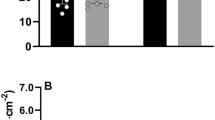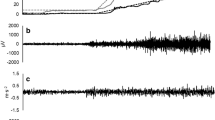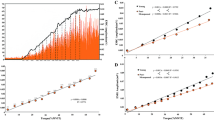Abstract
Purpose
The purpose of this study was to examine the responses of electromyographic (EMG) and mechanomyographic (MMG) amplitude across the torque spectrum in pre- and post-pubescent males and females.
Methods
Forty pre-pubescent (mean ± 95% confidence interval, age = 9.79 ± 0.35 years, n = 10 males, n = 10 females) and post-pubescent (age = 17.23 ± 0.58 years, n = 10 males, n = 10 females) participants completed this study. Participants completed maximal voluntary isometric contractions (MVICs) of the forearm flexors and extensors, as well as isometric ramp muscle actions. EMG and MMG amplitude were quantified from the biceps brachii, brachialis, and brachioradialis during all muscle actions. EMG and MMG amplitude during the isometric ramp muscle actions were normalized to EMG and MMG amplitude from the MVICs.
Results
The pre-pubertal group tended to have greater relative EMG amplitude across intensity (P < 0.050), while the post-pubertal group had a more pronounced increase in EMG amplitude at higher intensities. Similarly, the pre-pubertal group tended to have greater relative MMG amplitude across intensity (P ≤ 0.004) that plateaued earlier than the post-pubertal group (55% vs. 65%–75% of MVIC). Additionally, the pre-pubertal group had greater coactivation across intensity (P ≤ 0.001).
Conclusion
The greater relative EMG and MMG amplitude in the pre-pubertal group, in conjunction with the earlier plateau in MMG amplitude for the pre-pubertal group and greater coactivation, suggests less efficient muscle activation and motor unit recruitment strategies during pre-pubescence. Taken together, the findings of the present study suggest that growth-mediated changes in neuromuscular function lead to improvements in the efficiency of muscular activation and augmentations in motor unit recruitment strategies.





Similar content being viewed by others
Data Availability
The data that support the findings of this study are available from the corresponding author upon reasonable request.
References
Arabadzhiev T, Dimitrov V, Dimitrov G. The increase in surface EMG could be a misleading measure of neural adaptation during the early gains in strength. Eur J Appl Physiol. 2014;114:1645–55. https://doi.org/10.1007/s00421-014-2893-y.
Barry D, Cole N. Muscle sounds are emitted at the resonant frequencies of skeletal muscle. IEEE Trans Biomed Eng. 1990;37(5):525–31.
Beck T, Housh T, Johnson G, Weir J, Cramer J, Coburn J, Malek M. Mechanomyographic and electromyographic responses during submaximal to maximal eccentric isokinetic muscle actions of the biceps brachii. J Strength Cond Res. 2006;20(1):184–91. https://doi.org/10.1519/R-17605.1.
Bergeron M, Mountjoy M, Armstrong N, Chia M, Cote J, Emery C, Faigenbaum A, Hall G, Kriemler S, Leglise M, Malina R, Pensgaard A, Sanchez A, Soligard T, Sundgot-Borgen J, Mechelen W, Weissensteiner J, Engebretsen L. International Olympic Committee consensus statement on youth athletic development. Br J Sports Med. 2015;49(13):843–51. https://doi.org/10.1136/bjsports-2015-094962.
Coburn JW, Housh TJ, Cramer JT, Weir JP, Miller JM, Beck TW, Malek MH, Johnson GO. Mechanomyographic and electromyographic responses of the vastus medialis muscle during isometric and concentric muscle actions. J Strength Cond Res. 2005;19(2):412–20. https://doi.org/10.1519/15744.1.
De Luca CJ. The use of Surface electromyography in biomechanics. J Appl Biomech. 1997;13(2):135–63. https://doi.org/10.1123/jab.13.2.135.
DeFreitas JM, Beck TW, Stock MS. Effects of strength training on mechanomyographic amplitude. Physiological Meas. 2012;33(8):1353–61. https://doi.org/10.1088/0967-3334/33/8/1353.
Faigenbaum AD, Kraemer WJ, Blimkie CJR, Jeffreys I, Micheli LJ, Nitka M, Rowland TW. Youth resistance training: Updated position statement paper from the National Strength and Conditioning Association. J Strength Cond Res. 2009;23(5 Suppl):60–79.
Falk B, Usselman C, Dotan R, Brunton L, Klentrou P, Shaw J, Gabriel D. Child-adult differences in muscle strength and activation pattern during isometric elbow flexion and extension. Appl Physiol Nutr Metab. 2009;34(4):609–15. https://doi.org/10.1139/H09-020.
Farina D, Merletti R, Enoka RM. The extraction of neural strategies from the surface EMG. J Appl Physiol. 2004;96(4):1486–95. https://doi.org/10.1152/japplphysiol.01070.2003.
Gaudet G, Raison M, Maso FD, Achiche S, Begon M. Intra- and intersession reliability of surface electromyography on muscles actuating the forearm during maximum voluntary contractions. J Appl Biomech. 2016;32(6):558–70. https://doi.org/10.1123/jab.2015-0214.
Gillen ZM, Shoemaker ME, McKay BD, Bohannon NA, Gibson SM, Cramer JT. Muscle strength, size, and neuromuscular function before and during adolescence. Eur J Appl Physiol. 2019;119(7):1619–32. https://doi.org/10.1007/s00421-019-04151-4.
Gillen ZM, Housh TJ, Schmidt RJ, Herda TJ, De Ayala RJ, Shoemaker ME, Cramer JT. Comparisons of muscle strength, size, and voluntary activation in pre- and post-pubescent males and females. Eur J Appl Physiol. 2021;121(9):2487–97. https://doi.org/10.1007/s00421-021-04717-1.
Granados A, Gebremariam A, Lee JM. Relationship between timing of peak height velocity and pubertal dtaging in boys and girls. J Clin Res Pediatr Endocrinol. 2015;7(3):235–7. https://doi.org/10.4274/jcrpe.2007.
Gravetter FJ, Wallnau LB. Statistics for the behavioral sciences. 10th Edition. Boston, MA: Cengage Learning; 2017.
Grosset JF, Mora I, Lambertz D, Pérot C. Voluntary activation of the triceps surae in prepubertal children. J Electromyogr Kinesiol. 2008;18(3):455–65. https://doi.org/10.1016/j.jelekin.2006.11.002.
Herda TJ, Weir JP, Ryan ED, Walter AA, Costa PB, Hoge KM, Beck TW, Stout JR, Cramer JT. Reliability of absolute versus log-transformed regression models for examining the torque-related patterns of response for mechanomyographic amplitude. J Neurosci Methods. 2009;179(2):240–6. https://doi.org/10.1016/j.jneumeth.2009.01.028.
Herda TJ, Housh TJ, Fry AC, Weir JP, Schilling BK, Ryan ED, Cramer JT. A noninvasive, log-transform method for fiber type discrimination using mechanomyography. J Electromyogr Kinesiol. 2010;20(5):787–94.
Herda TJ, Walter AA, Costa PB, Ryan ED, Stout JR, Cramer JT. Differences in the log-transformed electromyographic–force relationships of the plantar flexors between high- and moderate-activated subjects. J Electromyogr Kinesiol. 2011;21(5):841–6.
Herda TJ, Trevino MA, Sterczala AJ, Miller JD, Wray ME, Dimmick HL, Gallagher PM, Fry AC. Muscular strength and power are correlated with motor unit action potential amplitudes, but not myosin heavy chain isoforms in sedentary males and females. J Biomech. 2019;86:251–5. https://doi.org/10.1016/j.jbiomech.2019.01.050.
Herda TJ, Miller JD, Wray ME, Sterczala AJ, Dimmick HL, Trevino MA. Motor unit firing rates of the first dorsal interosseous differ between male and female children aged 8 to 10 years. Hum Mov Sci. 2019;66:416–24. https://doi.org/10.1016/j.humov.2019.04.011.
Hermens HJ. SENIAM 8: European Recommendations for Surface Electromyography. 2nd Edition. Enschede, the Netherlands: Roessingh Research and Development; 1999.
Jenkins N, Housh T, Buckner S, Bergstrom H, Cochrane K, Hill E, Smith C, Schmidt R, Johnson G, Cramer J. Neuromuscular adaptations after 2 and 4 weeks of 80% versus 30% 1 repetition maximum resistance training to failure. J Strength Cond Res. 2016;(30):2174–85. https://doi.org/10.1519/JSC.0000000000001308.
Jenkins N, Miramonti A, Hill E, Smith C, Cochrane-Snyman K, Housh T, Cramer J. Mechanomyographic amplitude is sensitive to load-dependent neuromuscular adaptations in response to resistance training. J Strength Conditioning Res. 2019;35(11):3265–9. https://doi.org/10.1519/JSC.0000000000003276.
Khairullah A, Klein LC, Ingle SM, May MT, Whetzel CA, Susman EJ, Paus T. Testosterone trajectories and reference ranges in a large longitudinal sample of male adolescents. PLoS ONE. 2014;9(9):e108838. https://doi.org/10.1371/journal.pone.0108838.
Klein KO, Martha PM Jr, Blizzard RM, Herbst T, Rogol AD. A longitudinal assessment of hormonal and physical alterations during normal puberty in boys. II. Estrogen levels as determined by an ultrasensitive bioassay. J Clin Endocrinol Metab. 1996;81(9):3203–7. https://doi.org/10.1210/jc.81.9.3203.
Kluka V, Martin V, Vicencio SG, Jegu A-G, Cardenoux C, Morio C, Coudeyre E, Ratel S. Effect of muscle length on voluntary activation level in children and adults. Med Sci Sports Exerc. 2015;47(4):718–24. https://doi.org/10.1249/MSS.0000000000000463.
Kluka V, Martin V, Vicencio SG, Giustiniani M, Morel C, Morio C, Coudeyre E, Ratel S. Effect of muscle length on voluntary activation of the plantar flexors in boys and men. Eur J Appl Physiol. 2016;116(5):1043–51. https://doi.org/10.1007/s00421-016-3362-6.
Lambertz D, Mora I, Grosset J-F, Pérot C. Evaluation of musculotendinous stiffness in prepubertal children and adults, taking into account muscle activity. J Appl Physiol. 2003;95(1):64–72. https://doi.org/10.1152/japplphysiol.00885.2002.
Lloyd R, Cronin J, Faigenbaum A, Haff G, Howard R, Kraemer W, Micheli L, Myer G, Oliver J. National Strength and Conditioning Association position statement on long-term athletic development. J Strength Cond Res. 2016;30(6):1491–509. https://doi.org/10.1519/JSC.0000000000001387.
Marshall WA, Tanner JM. Variations in pattern of pubertal changes in girls. Arch Dis Child. 1969;44(235):291–303. https://doi.org/10.1136/adc.44.235.291.
Marshall WA, Tanner JM. Variations in the pattern of pubertal changes in boys. Arch Dis Child. 1970;45(239):13–23. https://doi.org/10.1136/adc.45.239.13.
Miller JD, Sterczala AJ, Trevino MA, Wray ME, Dimmick HL, Herda TJ. Motor unit action potential amplitudes and firing rates during repetitive muscle actions of the first dorsal interosseous in children and adults. Eur J Appl Physiol. 2019;119(4):1007–18. https://doi.org/10.1007/s00421-019-04090-0.
Mirwald RL, Baxter-Jones ADG, Bailey DA, Beunen GP. An assessment of maturity from anthropometric measurements. Med Sci Sports Exerc. 2002;34(4):689–94. https://doi.org/10.1097/00005768-200204000-00020.
Nielsen CT, Skakkebaek NE, Darling JA, Hunter WM, Richardson DW, Jørgensen M, Keiding N. Longitudinal study of testosterone and luteinizing hormone (LH) in relation to spermarche, pubic hair, height and sitting height in normal boys. Acta Endocrinol Suppl. 1986;279:98–106.
O’Brien TD, Reeves ND, Baltzopoulos V, Jones DA, Maganaris CN. The effects of agonist and antagonist muscle activation on the knee extension moment–angle relationship in adults and children. Eur J Appl Physiol. 2009;106(6):849–56. https://doi.org/10.1007/s00421-009-1088-4.
O’Brien TD, Reeves ND, Baltzopoulos V, Jones DA. In vivo measurements of muscle specific tension in adults and children. Exp Physiol. 2010;95(1):202–10. https://doi.org/10.1113/expphysiol.2009.048967.
Orizio C. Muscle sound: bases for the introduction of a mechanomyographic signal in muscle studies. Crit Rev Biomed Eng. 1993;21(3):201–43.
Pişkin İE, Gümüş M, Bayraktaroğlu T, Akalin TC, Yamaner F. Growth and pubertal development in adolescent male wrestlers. J Sports Med Phys Fit. 2018;58(6):852–6.
Pitcher CA, Elliott CM, Williams SA, Licari MK, Kuenzel A, Shipman PJ, Valentine JP, Reid SL. Childhood muscle morphology and strength: Alterations over six months of growth. Muscle Nerve. 2012;46(3):360–6. https://doi.org/10.1002/mus.23326.
Pope ZK, Hester GM, Benik FM, DeFreitas JM. Action potential amplitude as a noninvasive indicator of motor unit-specific hypertrophy. J Neurophysiol. 2016;115(5):2608–14. https://doi.org/10.1152/jn.00039.2016.
Round JM, Jones DA, Honour JW, Nevill AM. Hormonal factors in the development of differences in strength between boys and girls during adolescence: a longitudinal study. Ann Hum Biol. 1999;26(1):49–62. https://doi.org/10.1080/030144699282976.
Ryan E, Cramer J, Housh T, Beck T, Herda T, Hartman M, Stout J. Inter-individual variability among the mechanomyographic and electromyographic amplitude and mean power frequency responses during isometric ramp muscle actions. Electromyogr Clin Neurophysiol. 2007;47(3):161.
Seger JY, Thorstensson A. Muscle strength and myoelectric activity in prepubertal and adult males and females. Eur J Appl Physiol Occup Physiol. 1994;69(1):81–7. https://doi.org/10.1007/BF00867932.
Seger JY, Thorstensson A. Muscle strength and electromyogram in boys and girls followed through puberty. Eur J Appl Physiol Occup Physiol. 2000;81(1–2):54–61. https://doi.org/10.1007/PL00013797.
Stokes MJ, Dalton PA. Acoustic myography: Applications and considerations in measuring muscle performance. Isokinet Exerc Sci. 1993;3(1):4–15. https://doi.org/10.3233/IES-1993-3101.
Vincent WJ, Weir JP. Statistics in Kinesiology. 5th Edition. Champaign, IL: Human Kinetics; 2020.
Warburton DER, Jamnik VK, Bredin SSD, Gledhill N. The Physical Activity Readiness Questionnaire for Everyone (PAR-Q+) and Electronic Physical Activity Readiness Medical Examination (ePARmed-X+). Health Fit J Can. 2011;4:3–23.
Wood LE, Dixon S, Grant C, Armstrong N. Elbow flexion and extension strength relative to body or muscle size in children. Med Sci Sports Exerc. 2004;36(11):1977–84. https://doi.org/10.1249/01.MSS.0000145453.02598.7E.
Zacharias L, Rand WM. Adolescent growth in height and its relation to menarche in contemporary American girls. Ann Hum Biol. 1983;10:209–22. https://doi.org/10.1080/03014468300006381.
Acknowledgements
Efforts for this study were funded, in part, by a National Strength and Conditioning Association Foundation (NSCAF) Graduate Research Doctoral Grant, the University of Nebraska Agriculture Research Division with funds provided by the Hatch Act (Agency: U.S. Department of Agriculture, National Institute of Food and Agriculture; Accession No: 1000080; Project No: NEB-36-078) and a grant from Abbott Nutrition, Columbus, OH. The authors would like to thank Nicholas Bohannon and Sydney Gibson for their help conducting the study, as well as each of the subjects for their participation.
Author information
Authors and Affiliations
Corresponding author
Ethics declarations
Conflict of Interest
On behalf of all authors, the corresponding author states that there is no conflict of interest.
Consent to participate
was obtained from all participants.
Consent for publication
All authors have read and agreed to the published version of the manuscript.
Additional information
Publisher’s Note
Springer Nature remains neutral with regard to jurisdictional claims in published maps and institutional affiliations.
Electronic Supplementary Material
Below is the link to the electronic supplementary material.
Rights and permissions
Springer Nature or its licensor holds exclusive rights to this article under a publishing agreement with the author(s) or other rightsholder(s); author self-archiving of the accepted manuscript version of this article is solely governed by the terms of such publishing agreement and applicable law.
About this article
Cite this article
Gillen, Z.M., Housh, T.J., Schmidt, R.J. et al. Differences in Neuromuscular Responses During Isometric Muscle Actions Before and After Pubescence. J. of SCI. IN SPORT AND EXERCISE 6, 22–34 (2024). https://doi.org/10.1007/s42978-022-00199-5
Received:
Revised:
Accepted:
Published:
Issue Date:
DOI: https://doi.org/10.1007/s42978-022-00199-5




